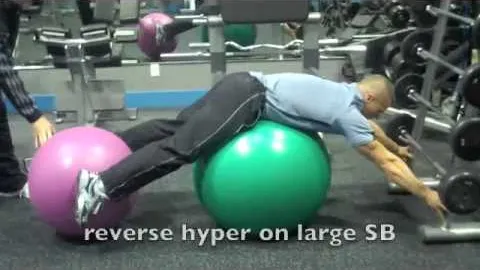
The Reverse Hyperextension with Stability Ball exercise is an effective workout for targeting the lower back muscles, hamstrings, and glutes. This exercise involves using a stability ball to provide additional support and stability, allowing for a controlled and safe movement.
The Reverse Hyperextension with Stability Ball exercise offers numerous benefits for individuals looking to strengthen their lower back and improve overall core stability. Some of the key benefits include:
The Reverse Hyperextension with Stability Ball exercise specifically targets the muscles in the lower back, helping to strengthen and tone this often overlooked area. By focusing on the lower back muscles, this exercise can help prevent and alleviate lower back pain.
Performing this exercise regularly can help improve hamstring flexibility. Tight hamstrings can lead to a variety of issues, such as lower back pain and poor posture. By incorporating the Reverse Hyperextension with Stability Ball exercise into your routine, you can increase hamstring flexibility and reduce the risk of injury.
The glute muscles are an essential part of a strong and stable core. Engaging the glutes during the Reverse Hyperextension with Stability Ball exercise can help strengthen these muscles, leading to better overall core stability and improved athletic performance.
The stability ball adds an element of instability to this exercise, which requires the core muscles to engage and stabilize the body throughout the movement. This helps to improve core strength and stability, leading to better posture and balance.
Consistently performing the Reverse Hyperextension with Stability Ball exercise can help improve posture by strengthening the muscles of the lower back and core. This can have a positive impact on everyday activities, such as sitting and standing for extended periods.
Follow the step-by-step guide below to properly perform the Reverse Hyperextension with Stability Ball exercise:
Start by placing the stability ball on the floor and lie facedown with your hips resting on the ball. Position your feet wider than shoulder-width apart for stability.
Extend your arms in front of you or place them on the sides of your head for additional support.
Engage your core and squeeze your glutes to lift your legs until they're parallel to the floor. Keep your toes pointed towards the ground.
Hold this position for a brief pause and then slowly lower your legs back down to the starting position.
Repeat the exercise for the desired number of repetitions.
To maximize the effectiveness and safety of the Reverse Hyperextension with Stability Ball exercise, keep the following tips in mind:
Start with lighter weights or bodyweight only to master the correct form and build stability.
Avoid using momentum to lift or lower your legs. Instead, focus on using your muscles to control the movement.
Engage your core throughout the exercise to maintain stability and protect your lower back.
Breathe steadily throughout the movement, exhaling as you lift your legs and inhaling as you lower them.
The Reverse Hyperextension with Stability Ball exercise is a versatile and effective exercise for targeting the lower back, hamstrings, and glutes. Incorporating this exercise into your fitness routine can help improve lower back strength, enhance hamstring flexibility, activate the glutes, increase core stability, and improve posture. Remember to perform the exercise with proper form and technique, and consult with a fitness professional if you have any pre-existing conditions or concerns. Start slow, gradually increasing the intensity as your strength and stability improve.
If you're looking for a gym, fitness club or yoga studio, you've come to the right place.
You can find information about gyms in your area. Browse catalog of gyms and find gyms with classes which are you looking for.
On gym page you can find simple information like address, phone or website. You can find list of available classes. You can check availability of personal training or small group classes. On place page you can also see information about open hours.
You can find gyms near you with amenities, courts, studios and equipments.
Use our map to find gym at your city or district.
In Gym Navigator you can find list of exercises with movies for many body parts.
You can browse exercises catalog and find exercises the best of you.
You can also find exercises grouped into workout plans, which you can use to improve you body. Each routine show you exercises one by one and give you possibility to count you progress and count down rest time.